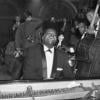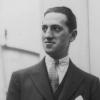
Since the mid-2000s, pianist and composer Jason Moran has been assuming the dual role of modernist and jazz antiquarian, exhuming figures from the past, recreating their styles, and sending them into the present day.
Pianists Thelonious Monk and Fats Waller have already been put through the process, and at Walt Disney Concert Hall on Friday night, Oct. 11, Moran returned to another long-running cause celebre: the legacy of composer and bandleader James Reese Europe. Together, Monk, Waller, and Europe form a trilogy of Harlem-based musicians, of which Europe is the least-known and most enigmatic.

Born around 1880 in Mobile, Alabama, Europe took violin lessons from the grandson of 19th-century orator and activist Frederick Douglass. Europe came to New York in 1904 and by 1910 had formed a union for Black musicians, the Clef Club, and an orchestra that performed in Carnegie Hall in 1912, well ahead of Rhapsody in Blue’s breakthrough in 1924 and bandleader Benny Goodman’s famous 1938 concert there — two jazz milestones more commonly cited in the history of the venue. Europe’s huge 125-member Clef Club Orchestra only performed music by Black composers, and they took the New York society and dance scenes by storm.
Europe achieved even greater fame during World War I as both a commanding officer and touring bandleader with the all-Black 369th Infantry Regiment — also known as the Harlem Hellfighters. After returning to the U.S. in early 1919, he tried to expand his musical horizons with recordings and a concert tour. But in May of that year, an argument with one of his drummers, Herbert Wright, turned violent. Wright stabbed Europe in the neck with a penknife, the seemingly minor wound would not stop bleeding, and Europe died shortly thereafter. The murder made headlines, and Europe became the first Black American to receive a public funeral in New York. He had the honor of being buried in Arlington National Cemetery.
Yet Europe’s fame has evaporated since. One theory is that he didn’t live long enough to make decent-sounding recordings that could convey the power of his music. His orchestra made a few acoustical 78s in 1913 and 1914 for the Victor Talking Machine Company and several more in 1919 for the French label Pathé Records, and they give us a dim, emaciated idea of what the group’s syncopated charts might have sounded like. Also, perhaps owing to the raw deals often handed to Black artists by the music industry, Europe wasn’t given lasting credit for some of his accomplishments. Early recordings of the hit tune “Ballin’ the Jack” list him as co-composer (with Chris Smith), but subsequent cover versions erase Europe’s name, and Jim Burris is given co-credit. Even to this day, Wikipedia’s entry on the song makes no mention of Europe.

What Moran has done is a revelation. Europe’s music has become a stimulating launchpad for the pianist’s stream-of-consciousness excursions around what jazz became over the course of a century. Musically, Friday’s performance was like going back and forth in a time tunnel, the entrances of which were 100 years apart.
With his back to the audience, Moran sat at a lidless grand piano facing a nine-piece ensemble called the Big Bandwagon — a setup not dissimilar to a Mozart piano concerto. The band consisted of Moran’s piano-trio mates, plus two saxophonists, a clarinetist doubling flute, a trumpet player, two trombonists, and a fiberglass sousaphone player taking the place of a tubist. It was also a multimedia presentation, the performance accompanied by a series of projected impressionistic black-and-white images, including fascinating rare films of the 369th Regiment parading and sailing off to France to play and fight in the war.
Moran sang Europe and Noble Sissle’s “All of No Man’s Land Is Ours” very casually while accompanying himself on the piano (Europe would have played the piano to Sissle’s vocals). Then the whole band fell in with a rousing march broken up by a transition into exciting freeform chaos, as if the material had been passed on to avant-gardist Albert Ayler for comment.

Later the stage was illuminated with moody blue lighting and mournful music to match, eventually giving way to a fusion of foghorn-like prerecorded electronica punctuated by Moran’s piano. A trio of blues numbers by W.C. Handy — “Memphis Blues,” the famous “St. Louis Blues,” and “Hesitating Blues” — was laid down, with Justin Faulkner’s drums injecting much life into what present-day ears might regard as somewhat stilted-sounding charts.
At the close of the mostly uninterrupted 58-minute suite — which Moran recorded as a 2023 album titled From the Dancehall to the Battlefield — there was a meditative lament, Pauline Oliveros’s “Zena’s Circle,” in which the members of the band gathered around Moran’s piano, the inner rim of which was now illuminated by several light bulbs. Finally, Moran presented his own tribute to Europe, “For James,” a piece with a moderate funk beat during which the pianist got the audience singing along with the tune. The number was dedicated to the late jazz pianist Randy Weston, who Moran says spent five hours lecturing him about Europe’s importance to Black history.
Whether Europe’s music should be considered proto-jazz or post-ragtime or something else is still up for debate. It seems to point the way most directly toward bandleader Paul Whiteman’s inflated idea of symphonic dance music. Yet in this concert, the Big Bandwagon made the Harlem Hellfighters’ music come alive in a way that old recordings simply can’t, connecting the material with later developments in Black music and delivering it all in the proud, understated way of a band of freedom fighters.




